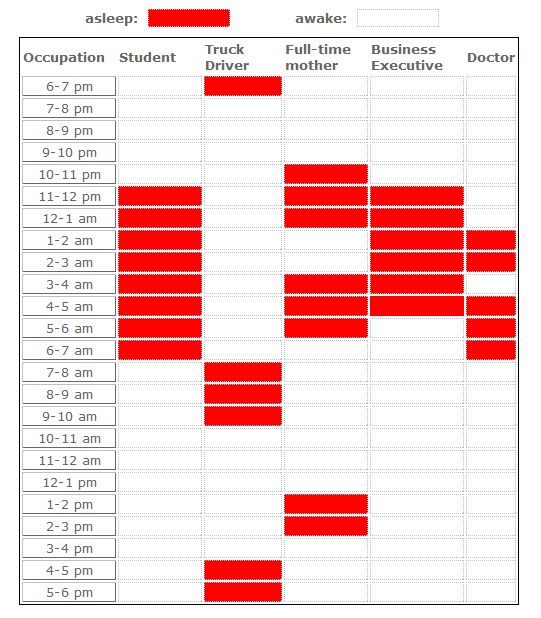The chart below shows the sleep patterns of people in five different occupations according to a Canadian study.
Answer:
A study conducted by a Canadian presented in the chart above provides the information about the sleep patterns of people in five different jobs.
Overall, both students and business executives sleep in consecutive hours, while truck drivers, full-time mothers and doctors have broken sleep schedules.
According to the data, truck drivers tend to spend 6-hour sleep, but they have non-consecutive sleep schedules, between 7 and 10 a.m. and another from 4 to 7 p.m. However, if compared with doctors who have sleep deprivation, the non-consecutive pattern of sleep for full-time mothers with sleeping total of around 8 hours gives them two hours for nap in the afternoon.
It can be seen from the data doctors having the emergency calls from the patients in the middle of night and full-time mothers who have babies causing the disturbance to them are highly likely to lay awake half the night. However, the data, again, show sleeping like a log happens to students and business executives. Retiring to bed at 11-12 p.m. and getting up two hours earlier than students who typically sleep for a consecutive 8-hour period each night, from 11 p.m. to 7 a.m. make the business executive spend only 6 hours at bed, perhaps the schedule for work needing them to wake up around 5-6 a.m.
Answer:
A study conducted by a Canadian presented in the chart above provides the information about the sleep patterns of people in five different jobs.
Overall, both students and business executives sleep in consecutive hours, while truck drivers, full-time mothers and doctors have broken sleep schedules.
According to the data, truck drivers tend to spend 6-hour sleep, but they have non-consecutive sleep schedules, between 7 and 10 a.m. and another from 4 to 7 p.m. However, if compared with doctors who have sleep deprivation, the non-consecutive pattern of sleep for full-time mothers with sleeping total of around 8 hours gives them two hours for nap in the afternoon.
It can be seen from the data doctors having the emergency calls from the patients in the middle of night and full-time mothers who have babies causing the disturbance to them are highly likely to lay awake half the night. However, the data, again, show sleeping like a log happens to students and business executives. Retiring to bed at 11-12 p.m. and getting up two hours earlier than students who typically sleep for a consecutive 8-hour period each night, from 11 p.m. to 7 a.m. make the business executive spend only 6 hours at bed, perhaps the schedule for work needing them to wake up around 5-6 a.m.

sleep_pattern.png
